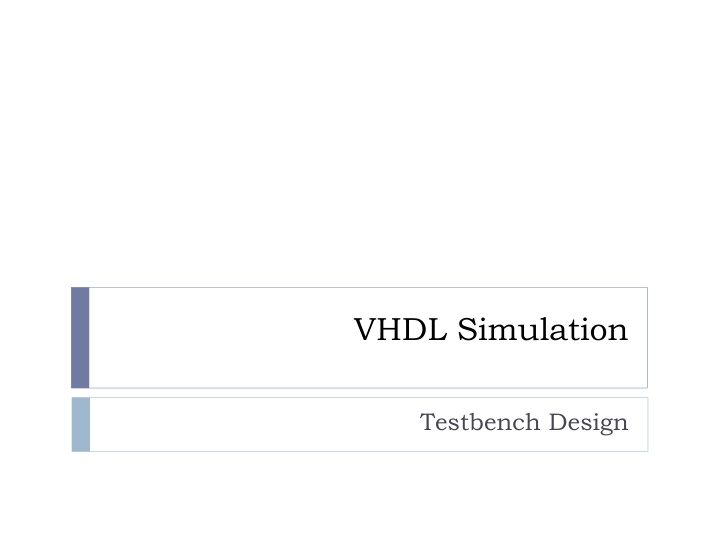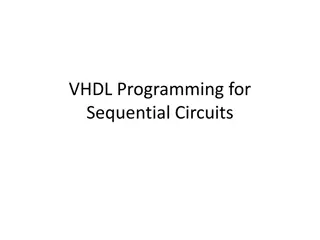Comprehensive VHDL Simulation Testbench Design Overview
In this detailed content, you will explore the concepts of VHDL simulation testbench design, project simulations in VHDL/Verilog, post-synthesis and post-layout processes, and example implementation of a modulo-7 counter VHDL model. The tutorial covers creating working libraries, mapping libraries, compiling, simulating, and analyzing results using ModelSim. Additionally, it provides insights into developing a parallel-load modulo-7 synchronous counter in VHDL with code snippets and test stimulus generation using ModelSim files.
Download Presentation

Please find below an Image/Link to download the presentation.
The content on the website is provided AS IS for your information and personal use only. It may not be sold, licensed, or shared on other websites without obtaining consent from the author.If you encounter any issues during the download, it is possible that the publisher has removed the file from their server.
You are allowed to download the files provided on this website for personal or commercial use, subject to the condition that they are used lawfully. All files are the property of their respective owners.
The content on the website is provided AS IS for your information and personal use only. It may not be sold, licensed, or shared on other websites without obtaining consent from the author.
E N D
Presentation Transcript
VHDL Simulation Testbench Design
Project simulations Behavioral/RTL verify functionality Model in VHDL/Verilog Drive with force file or testbench Post-Synthesis Synthesized gate-level VHDL/Verilog netlist Technology-specific VHDL/Verilog gate-level models Optional SDF file (from synthesis) for timing Drive with same force file/testbench as in (1) Post-Layout Netlist back-annotated with extracted capacitances for accurate delays 1. 2. 3.
Example: modulo-7 counter VHDL Model (modulo7.vhd) Create working library: vlib work Map the lib name: vmap work work Compile: vcom modulo7.vhd Simulate: vsim modulo7(behave) Simulation-control Modelsim macro file (mod7.do) Testbench (VHDL or Verilog) ModelSim results List(table) and/or Waveform (logic analyzer)
-- modulo7.vhd parallel-load modulo-7 synchronous counter library ieee; use ieee.std_logic_1164.all; use ieee.numeric_std.all; entity modulo7 is port(reset,count,load,clk: in std_logic; I: in std_logic_vector(2 downto 0); Q: out std_logic_vector(2 downto 0)); end modulo7; architecture Behave of modulo7 is signal Q_s: unsigned(2 downto 0); begin process (reset,clk) begin if (reset='0') then Q_s <= "000"; elsif (clk'event and (clk='1')) then if (count = '1') and (Q_s = "110") then Q_s <= "000"; elsif (count='1') then Q_s <= Q_s + 1; elsif (load='1') then Q_s <= UNSIGNED(I); end if; end if; end process; Q<=STD_LOGIC_VECTOR(Q_s); end Behave;
Test stimulus: Modelsim do file: mod7.do add wave /clk /reset /count /load add wave -hex /I /Q add list /clk /reset /count /load add list -hex /I /Q force /clk 0 0 ns, 1 20 ns -repeat 40 ns force /I 101 0 ns, 011 400 ns force /reset 1 0 ns, 0 10 ns, 1 20 ns force /count 0 0 ns, 1 90 ns, 0 490 ns force /load 0 0 ns, 1 30 ns, 0 70 ns run 600 ns
Results in list format Note delta delays for behavioral model.
Elements of a VHDL/Verilog testbench Unit Under Test (UUT) or Device Under Test (DUT) instantiate one or more UUT s Stimulus of UUT inputs algorithmic from arrays from files Checking of UUT outputs assertions write to files
Instantiating the UUT -- 32 bit adder testbench entity adder_bench is -- no top-level I/O ports end adder_bench; architecture test of adder_bench is component adder is -- declare the UUTs port ( X,Y: in std_logic_vector(31 downto 0); Z: out std_logic_vector(31 downto 0) ); signal A,B,Sum: std_logic_vector(31 downto 0); --internal signals begin UUT: adder port map (A,B,Sum); --instantiate the adder
Example stimulating clock inputs -- Simple 50% duty cycle clock clk <= not clk after T ns; -- T is constant or defined earlier -- Clock process, using wait to suspend for T1/T2 process begin clk <= 1 ; wait for T1 ns; -- clk high for T1 ns clk <= 0 ; wait for T2 ns; -- clk low for T2 ns end process; -- Clock procedure (define in declaration area or in a package) procedure Clock (signal C: out bit; HT, LT: TIME) is begin loop -- schedule waveform on C and suspend for period C <= 1 after LT, 0 after LT + HT; wait for LT + HT; end loop; end procedure; -- execute clock procedure by instantiating it in the architecture C1: Clock (CLK, 10ns, 8 ns);
Algorithmic generation of stimulus -- Generate test values for an 8-bit adder inputs A & B process begin for m in 0 to 255 loop -- all 8 bit addend values for n in 0 to 255 loop -- all 8 bit augend values A <= to_std_logic(m); -- apply m to adder input A B <= to_std_logic(n); -- apply n to adder input B wait for T ns; -- allow time for addition assert (to_integer(Sum) = (m + n)) -- expect Sum = A + B report Incorrect sum severity note; end loop; end loop; end process;
Sync patterns with clock transitions -- Test 4x4 bit multiplier algorithm process begin for m in 0 to 15 loop; for n in 0 to 15 loop; A <= to_std_logic(m); -- apply multiplier B <= to_std_logic(n); -- apply multiplicand wait until CLK EVENT and CLK = 1 ; -- clock in A & B wait for 1 ns; -- move next change past clock edge Start <= 1 , 0 after 20 ns; -- pulse Start signal wait until Done = 1 ; -- wait for end of multiply wait until CLK EVENT and CLK = 1 ; -- finish last clock end loop; end loop; end process;
Reading test patterns from files use std.textio.all; -- Contains file/text support architecture m1 of bench is begin signal Vec: std_logic_vector(7 downto 0); -- test vector process file P: text open read_mode is "testvecs"; -- test vector file variable LN: line; -- temp variable for file read variable LB: bit_vector(31 downto 0); -- for read function begin while not endfile(P) loop -- Read vectors from data file readline(P, LN); -- Read one line of the file (type line ) read(LN, LB); -- Get bit_vector from line Vec <= to_stdlogicvector(LB); -- Vec is std_logic_vector end loop; end process;
Test vectors from an array type vectors is array (1 to N) of std_logic_vector(7 downto 0); signal V: vectors := -- initialize vector array ( "00001100 , -- pattern 1 "00001001 , -- pattern 2 "00110100", -- pattern 3 . . . . "00111100 -- pattern N ); begin A <= V(i); -- set A to ith vector
Check results with assertions -- Assert statement checks for expected condition assert (A = (B + C)) -- expect A = B+C (any boolean condition) report Error message severity NOTE; -- Print Error message if assert condition FALSE (condition is not what we expected) -- Specify one of four severity levels: NOTE, WARNING, ERROR, FAILURE -- Modelsim allows selection of severity level that should halt the simulation -- Severity level NOTE generally should not stop simulation
Check timing constraints -- Tsu for flip flop D input before clock edge is 2ns assert not (CK stableand (CK = 1 ) and not D stable(2ns)) report Setup violation: D not stable for 2ns before CK ; -- DeMorgan equivalent assert CK stableor (CK = 0 ) or D stable(2ns) report Setup violation: D not stable for 2ns before CK ;
Testbench: modulo7_bench.vhd LIBRARY ieee; USE ieee.std_logic_1164.all; USE ieee.numeric_std.all; Alternative to do file ENTITY modulo7_bench is end modulo7_bench; ARCHITECTURE test of modulo7_bench is component modulo7 PORT (reset,count,load,clk: in std_logic; I: in std_logic_vector(2 downto 0); Q: out std_logic_vector(2 downto 0)); end component; for all: modulo7 use entity work.modulo7(Behave); signal clk : STD_LOGIC := '0'; signal res, cnt, ld: STD_LOGIC; signal din, qout: std_logic_vector(2 downto 0); begin -- instantiate the component to be tested UUT: modulo7 port map(res,cnt,ld,clk,din,qout); Continue on next slide
Testbench: modulo7_bench.vhd qint = expected outputs of UUT clk <= not clk after 10 ns; P1: process variable qint: UNSIGNED(2 downto 0); variable i: integer; begin qint := "000"; din <= "101"; res <= '1'; cnt <= '0'; ld <= '0'; wait for 10 ns; res <= '0'; --activate reset for 10ns wait for 10 ns; assert UNSIGNED(qout) = qint report "ERROR Q not 000" severity WARNING; res <= '1'; --deactivate reset wait for 5 ns; --hold after reset ld <= '1'; --enable load wait until clk'event and clk = '1'; qint := UNSIGNED(din); --loaded value wait for 5 ns; --hold after load ld <= '0'; --disable load cnt <= '1'; --enable count for i in 0 to 20 loop wait until clk'event and clk = '1'; assert UNSIGNED(qout) = qint report "ERROR Q not Q+1" severity WARNING; if (qint = "110") then qint := "000"; --roll over else qint := qint + "001"; --increment end if; end loop; end process; Print message if incorrect result























